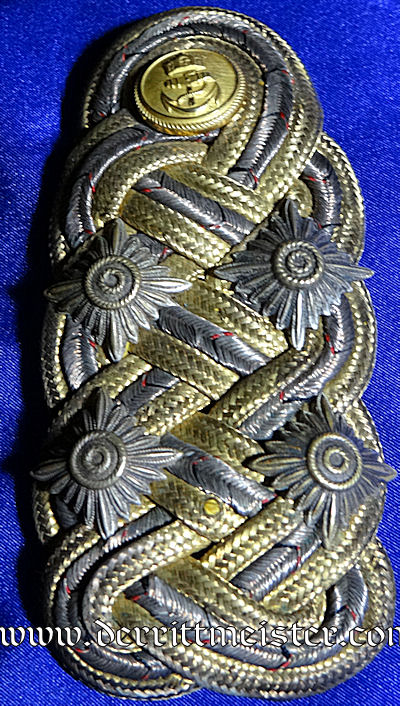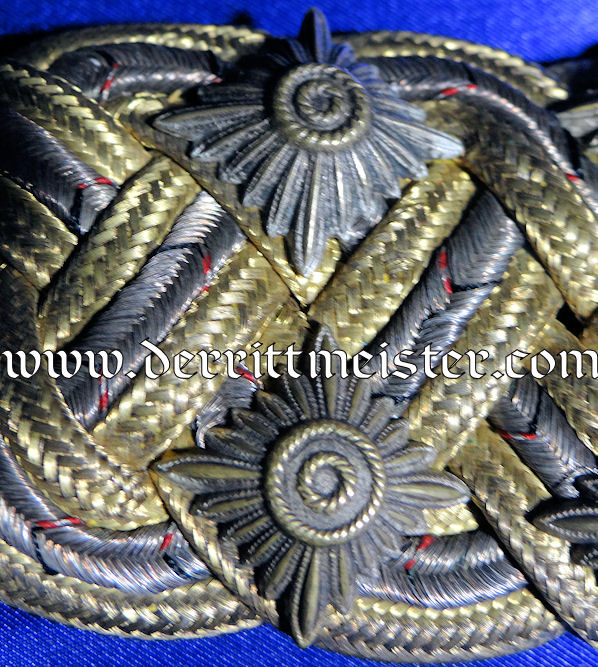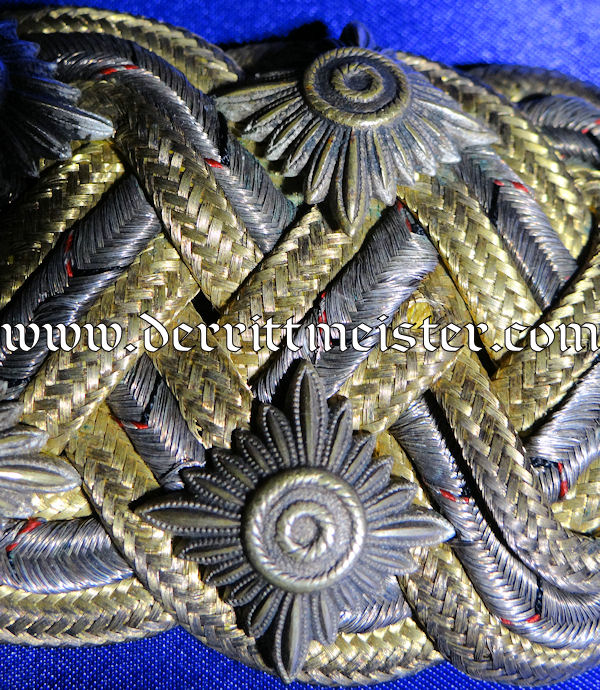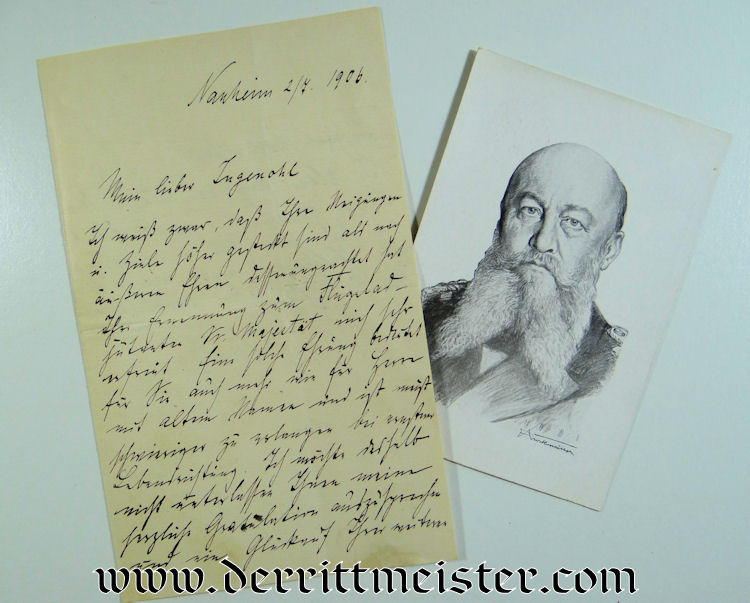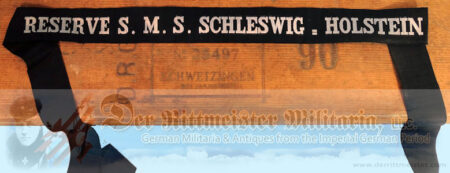Description
Alfred von Tirpitz (1849-1930) was one of the Kaiserliche Marine’s best known admiräle (admirals). He joined the Navy in 1865. At that time the Prussian Navy was very small and insignificant. [When the 1870-1871 Franco-Prussian War took place, the Prussian Navy was far outnumbered by the French Navy. The Prussians stayed in port during the conflict, (engendering embarrassment for their lack of participation)]. Early in his career, Tirpitz was involved in the development of torpedoes, then Torpedo-Boots. He held a number of administrative and tactical commands. In 1895, he was promoted to the rank of Konteradmiral. In 1899, he was promoted to Vizeadmiral. The following year he was ennobled. In 1903, he was promoted to the rank of Admiral. His final promotion was to Großadmiral, which took place in 1911. (We will return to that later). In the late 1890’s, he became more involved in the Kaiserliche Marine’s political/administrative arm. From 1897-1916, he served as the “Secretary of State of the Imperial German Naval Office.” Von Tirpitz was responsible for the Navy’s growth. With the Kaiser’s support, the Navy greatly increased its numbers of battleships and cruisers. This led to an arms race with England, with each country enlarging its Navy in competition with its rival.
Von Tirpitz also was responsible for building a fleet of U-Boots, as he felt that they would be very effective against England’s bigger ships (particularly those on duty in the eventual blockade that von Tirpitz realized was inevitable). He also knew submarines would help prevent cargo ships from delivering much needed war materials and food to England. [Interestingly, submarine warfare proved a major problem for Germany. Views about “unrestricted” submarine attacks on civilian targets raged pro and con within the Navy, as well as within the Kaiser’s circle, and those of other political/diplomatic entities. Germany’s unrestricted submarine warfare eventually became a prime motivator for the USA’s involvement in WW I].
By 1916, Kaiser Wilhelm withdrew his support for von Tirpitz (a handy scapegoat), forcing him to retire the same year. In 1917, von Tirpitz became involved in a new political party, eventually serving in the Reichstag during the 1920’s. Von Tirpitz remained an important figure within Germany’s military and public life until the late 1920’s. With the rise to party of the Nazi Party (NSDAP), a rebuilt German Luftwaffe (Air Force) and Kriegsmarine (Navy) came into existence. The Kriegsmarine built two modern Bismarck Class Battleships: the famous Bismarck was its lead ship, the Tirpitz was the second. The Bismarck was sunk in May 1941. Bottled up in Norwegian waters, the Tirpitz was not much of a major factor. Ultimately, bombers from the RAF sank her in November 1944.
To truly comprehend von Tirpitz’s importance, one first must understand the rank of Großadmiral. It was instituted by the Kaiserliche Marine in 1901. Prior to that date, the highest rank was Admiral, which was equal to the German Army’s General der Infanterie. As it was the top rank, the Navy had NO rank equivalent to the Army’s ranks of Generaloberst or Generalfeldmarschall. When the Großadmiral’s rank was instituted, it became equivalent to the Army’s rank of Generalfeldmarschall, (the Army’s Generaloberst rank still had NO equivalent).
Only SIX men became Großadmiräle (plural form) from the rank’s 1901 institution through the empire’s end in 1918. The first two, Kaiser Wilhelm II (1901) and Sweden’s King Oscar II (1901), were royals who held the rank on an honorary basis. The next two men, Hans von Koester (1905) and Prussia’s Prince Heinrich (1909), held the rank on a tactical basis. The final two men, Alfred von Tirpitz (1911)[held without patent] and Henning von Holtzendorff (1918), held the rank as the “Secretary of State of the Imperial German Naval Office,” the Navy’s TOP official.
You will note the phrase “held without patent” after Alfred von Tirpitz’s name. When he received his promotion on 27 January 1911, he was given the title “Großadmiral,” BUT did not receive its patent. The lack of that document signifies that von Tirpitz’s rank actually was LOWER than the other five Großadmiräle. The difference becomes evident when we study von Tirpitz’s shoulder boards. The other five Großadmiräle’s shoulder boards sported crossed batons like those of the Generalfeldmarschälle (GFM), while von Tirpitz displayed four pips on his. [Those of you familiar with the German Army’s shoulder boards know that officers who received a patent with their rank wore the crossed batons. Those officers who were designated Generaloberst in the rank of Generalfeldmarschall (an honorary rank generally given to royals WITHOUT direct command authority) sported shoulder boards with the crossed batons AND three pips (combining a Generalfeldmarschall’s crossed batons with a Generaloberst’s three pips), or displayed four pips by themselves]. This was exactly von Tirpitz’s situation. Unlike the other five men, he bore four pips on his shoulder boards and epaulettes.
Several years ago we offered a single von Tirpitz shoulder board with the same configuration. It came from a museum in Germany, and I was very excited to offer it. Today, we are offering ANOTHER single shoulder board that only could have belonged to Alfred von Tirpitz. The shoulder board measures 1 7/8″ x 4 3/16.” It displays four gilt-toned pips on its obverse. Its reverse reveals that it is of the slip-on variety, which is correct. Its backing material boasts a rich, 100% correct, navy-blue color that is proper for a naval officer’s shoulder boards. We can also see where each pip has been attached.
In addition we are offering a postcard which shows von Tirpitz in uniform. If you look closely at the shoulder board that he is wearing on his left shoulder, you will note that it has FOUR pips and not crossed batons. This confirms that von Tirpitz was the only man to have the rank of Großadmiral and to wear a shoulder board with FOUR pips. The shoulder board’s condition is excellent, overall. Interestingly, this shoulder board’s addition means we currently are offering items from THREE of the six Großadmiräle! Only Kaiser Wilhelm II, Prinz Heinrich, and Sweden’s King Oscar II are not currently represented in our inventory.
Also included in this grouping is a handwritten letter from Admiral Alfred von Tirpitz (1849-1930) to future admiral and commander of the Hochseeflotte (High Seas Fleet) from 1913-1915, Friedrich von Ingenohl (1857-1933). The letter has been written on a piece of paper that measures 9 5/8″ by 7 3/4.” It has been folded in half, which allows four different pages measuring 7 3/4″ x 4″ x 7/8″ for writing. Two of these pages are used in the letter to von Ingenohl.
The letter is dated 2 July 1905 and was written in Nauheim. At the time, von Tirpitz held the post of Naval Secretary of State. The letter is written in ink. Glancing through the letter, I see that von Tirpitz is congratulating von Ingenohl on the occasion of his appointment to serve as Kaiser Wilhelm II’s Flügeladjutant. The following year, von Ingenohl was transferred to command the Kaiser’s royal yacht, S. M. Y. Hohenzollern. (This is an historically important document as it shows when von Ingenohl got on the fast track to Admiral). The letter’s opening is simply “Meine Lieber Ingenohl.” It concludes with the clear and recognizable signature, v. Tirpitz. The letter is written in black ink. Someone with the time and inclination could fully translate the letter.
The letter is in excellent condition for being more than one-hundred-years-old. We will include a postcard of von Tirpitz, so that you can better enjoy the letter.
